In case you missed it, be sure to read Part 1, here.There were six days left and the hardest of them were yet to come.
We stood in the north Saharan desert in Mech Irdane, Morocco under a high sun at 7:00 AM. The all-women's navigation challenge known as the Rallye Aïcha des Gazelles was only two days old, and in spite of a cool morning, it was already clear we'd need to make peace with a grueling desert captivity. The desert has no friends.
Part 1 tells the unintentionally intense story of our arrival in Mech Irdane and how we ended up in a broiling nowhere, with 320 women engaged in a colossal game of Capture the Flag. The abstract is that for eight days in March, the 24-year-old rally puts 160 teams of two women apiece in four classes of vehicles, charged with finding 60 flags hidden somewhere in 10,000 square miles of desert, navigating with 55-year-old maps using nothing more complex than a compass and a plotter. It's not a race for time but one for distance – the winner is the team that finds the most flags having driving the shortest distance possible over those eight days. Each team has paid $18,540 to enter. The winning team gets a medal. There are no other official prizes.
There were six days left and the hardest of them were yet to come. Today, we had to get through the dunes of Erg Chebbi.
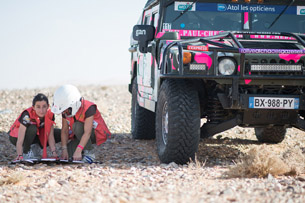
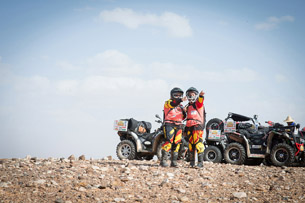
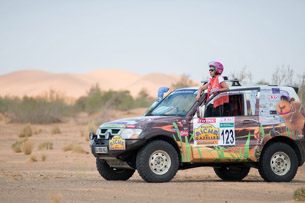
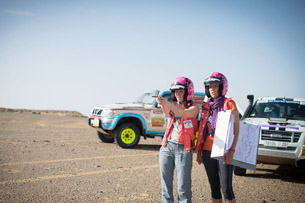
Erg Chebbi are the highest dunes in Morocco, a desert that is also a mountain. The day had nine checkpoints, 110 km, 9:30 to finish. Firm sand because of the recent rains helped teams get through the five checkpoints hidden within, but sharp peaks falling into steep faces still made for a lot of stuck trucks. Some opted to skip the four checkpoints after the dunes and take the road back to the bivouac, which had moved to Mech Irdane, because the next two days would be the first of two marathon legs.Erg Chebbi are the highest dunes in Morocco, a desert that is also a mountain.
Croft and Cahill made it to all the checkpoints in the dunes, but lost their way in the flats afterward. Said navigator Cahill, "I studied all these maps and was practicing on the Montana terrain, trying to do the best I could, but it's not the same until you are actually here doing it. You've got to get on the horse and ride."
The Hoehns nearly got bucked off theirs, both sisters struck by food poisoning. They spent hours driving in circles looking for CP 5, the whole day interspersed with repeated episodes of bodily revolt. Refusing to quit, they found the lost flag and then checked off one more, but gave up the hunt for the remaining two as the sun was going down. At the bivouac, both were sent to the medical tent. A severely dehydrated Susanah would remain there on an IV all night. Ranked 27th at the beginning of the stage, this was the first day they missed a checkpoint.
But the Indiana Joans had broken through: Hall and Howells got all the checkpoints on a leg, a feat they'd never accomplished. "This is the first time we've made it back to the bivouac while it's still light out," said Howells. "Did you know there's a bar?"
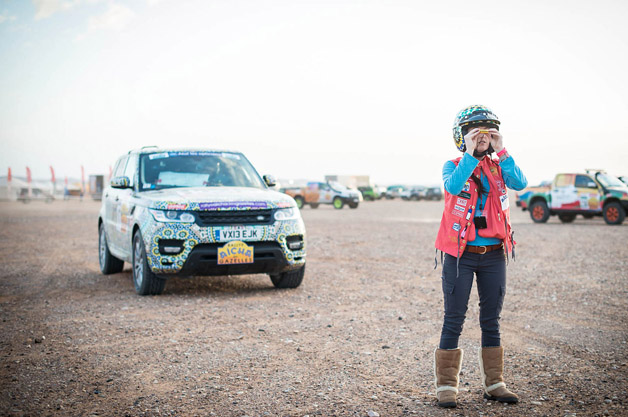
While most teams were back by 7:00 PM, the penultimate team didn't make it back until 11, and one team slept in the desert. Now, in addition to fatigue, you could see teams starting to crack – drivers and navigators in a forced marriage for 11 hours a day, many of whom barely knew one another before they arrived, angry at one another, angry at the race, at the desert, at the exhaustion, all that anger only making everything harder. Said Cathy Le Fur, doing the rally with her daughter in a Hummer H1, "It's very hard in the cockpit." And the hardest days – by far – were yet to come.
At the end of Day 3, the same team had led since the beginning: Jeanette James and Anne-Marie Borg, both Gazelles Rally veterans, with 22.87 penalty points after 427 km of laser-guided driving in their Amarok.
The organizers are always quick to stress, "The Rallye is not just passing through!" In the zone of the race, you scud over Morocco like ships in storms, shaken but aloft. When your ship springs a leak, the kingdom swallows you just as surely as its sand swallows all your engine's fluids.N 29 44.382
W 06 01.605
It is a good thing to begin with such a mishap, not only because it develops the fatalism necessary to the enjoyment of Africa, but because it lets one at once into the mysterious heart of the country.
– In Morocco (1920), Edith Wharton
During the second marathon leg, in the same 24-hour span that the desert claimed three media trucks, the Hoehns' race ended in the dunes of Oued Draa. A little too hot cresting a peak, they nosedived into a bowl bottomed with rock-hard sand. Airbags blown, windshield cracked, radiators busted. The race would send a flatbed to carry the Range Rover out of the dunes the next day, so a group of us camped with them. Other competitors had stopped for the night in nearby bowls, which turned our corner of the dunes into the weirdest block party I've ever encountered; hop over a couple of peaks in any direction and you'd find another little jamboree.The race would send a flatbed to carry the Range Rover out of the dunes the next day.
My media drivers at the time, Alberto and his wife Teresa, and race sheriffs Louise and Xavier, all veteran overlanders, found a dried bush and made a fire, then whipped up a full bar and a four-course meal I'd be happy to get in Los Angeles, never mind an anonymous GPS point in a brown oblivion. I had a sleeping bag but no tent, so I slept out in the open, on a plastic Kit-Kat tarp on the sand, in an iron silence encased in stars.
As we pulled out the next morning (leaving the Hoehns to wait with a brace of water bottles and instructions to "Follow the shade!" until the flatbed arrived), Alberto told me the race was sending mechanics to fix the Range Rover. I couldn't believe it. I told him the two women I thought I saw wouldn't go anywhere near that truck, too spooked by the dangerous and busted side of racing. "I bet they will," he said. "Just you wait." But the Hoehns never got the chance – the mechanics couldn't fix it, and a few more African "adventures," the kind called "WTF?" in most other countries, meant they didn't get back to the bivouac for two days.
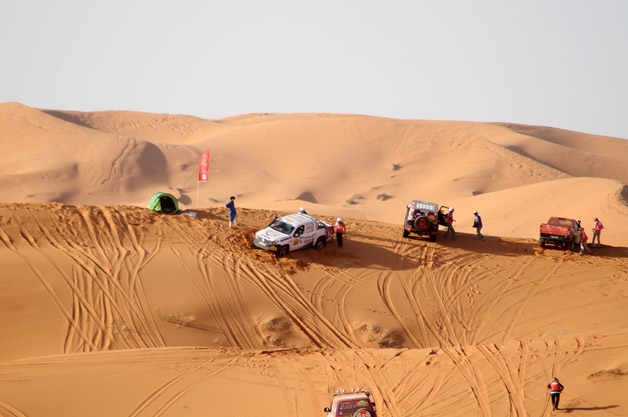
The day before my impromptu campout, Virginie Soulaire, the coach for the 15 teams that French oil company Total sends to the race, said she tells her women, "When you're in the deep shit, this will be your nicest memory." I can't speak for the Hoehns, but as far as I'm concerned, she was right.
The next four days and three nights were the crucible: two back-to-back marathon legs, with one bivouac night in between them. The other two nights you'd sleep in the desert wherever you decided to stop. In total, 26 checkpoints and at least 625 km of driving. These were the High Bible Days, the flock sent out into the wilderness to find the promised land, to be smote by the fires, or to just wander.Exodus
If one lose one's way in Morocco, civilization vanishes as though it were a magic carpet rolled up by a Djinn.
– In Morocco (1920), Edith Wharton
It was comically demanding. The maps offered such a poor representation of the first leg that we got lost trying to follow them. Florence Pham, who won the event last year with driver Syndielee Wade, said, "It felt like the mapmaker quit or the printer ran out of toner." Breaking the media truck (my fault) meant we had to find a welder somewhere in the desert who could repair a wishbone at 5:00 PM on a Sunday afternoon.

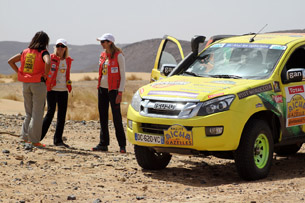
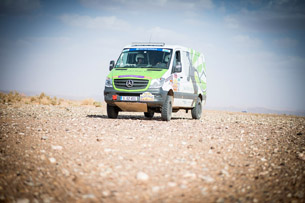
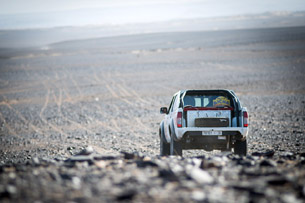
Getting through the Chegaga dunes proved more challenging than Erg Chebbi because of their layout and the heat – it was impossible to take them straight on, impossible not to sink. I was glad we weren't in the media truck that got stuck somewhere in those dunes for six hours. Listening to PC control beg any other media vehicle, "Would someone please go get the journalists stuck in the dunes?!" Other media drivers, toasted, replying, "We can't find them!" Flies, wind, sand blowing into your rations no matter which way you sat, then proper sandstorms to teach you not to complain about a little wind. More broken trucks and beat-up bodies too shot to continue. Ex-friends who broke all of their bonds in the race, ex-strangers now friends for life because of it. Elisabete Jacinto breaking her truck in the same way in the same dunes as last year, able to continue but out of the hunt.The Chegaga dunes proved more challenging than Erg Chebbi – it was impossible to take them straight on, impossible not to sink.
The desert a kiln during the final leg, heinous heat, grinding out the massive distances between checkpoints. Crossing the dry bed of Lac d'Iriqui where "shade" was a dirty word. Watching a competitor arrive at a checkpoint, get out of her truck, collapse, and whisper, "C'est l'enfer... c'est l'enfer...." Knowing that all I had to do was watch the race, but still thinking, "I'm tired. This needs to end."
Good news, too: the Hoehns were back in business and hitting all of their checkpoints until they, too literally, hit the ground running; The Indiana Joans locked and loaded, Howells saying, "Our communication is getting a lot better, my confidence has improved a lot. I used to not want to admit I was lost because I felt like I wasn't doing a good job. As a team we've gotten a lot better at compromising." And then Halls' take on it: "There were a few times when Sabrina would say, 'come this way,' and my only response was, 'I'm going to do die today.'" But not only did they not die, they hit every checkpoint for the rest of the race. Croft and Cahill, bugged by truck issues again, watching a squad of other Gazelles push their truck four times to jump start it, unsuccessfully. Then one of the other competitors smacked the battery and the truck roared to life.

The last day of the race in Foum-Zguid, after the marathon legs, another easy jaunt gone bad: post-sandstorm haze and airborne dust killing visibility and making supposedly-prominent features look the same. Last year's winners plotting CP 1 in the wrong place, eating 35 penalty points in a single day and being the last ones to cross the line and end the race, 18 hours after the day began. The thing finally over. Cahill summing it up nicely: "I can't believe I did it. What we went through to keep going with our car, I'm so relieved it's over, but we'll be back. We just don't know when. I think I'm allergic to maps now."
Jeannette James and Anne-Marie Borg winning the race from pole to flag, a total of 59.24 penalty points for the six stages, 5.86 points less than second-placed Elisabete Jacinto and Valérie Dot. Emme Hall and Sabrina Howells scored 29th place with 522.06 penalty points, Croft and Cahill came in 48th with 1,043.89. A ceremonial finish in Essaouira two days later, a prize-giving ceremony where James and Borg took possession of their medal, and awards were given out for milestones like 'prettiest truck,' then a formal gala with the competitors in ball gowns and heels.
I couldn't recognize any of them.
Weeks later, someone asked me if my time in Morocco was fun. "No," I said, "the same way an Ironman triathlon or climbing Everest isn't fun. Incredible. Amazing. Unforgettable. But not fun."Meeting The Oracle
It is like a desert traveler's dream in his last fever.
– In Morocco (1920), Edith Wharton
Dominique Serra said in an interview, "The rally is a trigger. There are women who get divorced when they go home, who get married, who change jobs."
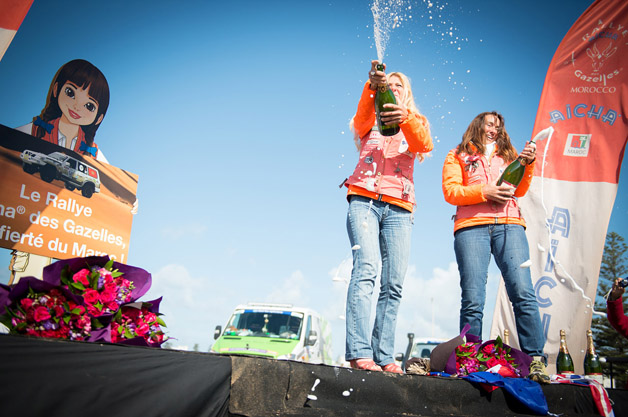
In that truth is the best analogy I can make: competing in the race is like visiting The Oracle in The Matrix – it tells you exactly what you need to hear. Actually locating the flags is merely the mechanics, the wires that transmit the message. It's what you find out about yourself in the search for those flags, how much you discover you can endure, that you can do, that you can overcome, that you can be in that search, that's the heart of the race. No one else will ever know what that is, not deeply, nor would they ever truly understand it. It's a message coded exclusively to you.It's what you find out about yourself in the search for those flags that's the heart of the race.
Sitting in the media tent with Jo Hanna Hoehn on the last day of the race, she said, "Normally I wouldn't be okay with crossing the finish line if I hadn't gone the whole way. But I feel like this time it's okay." I asked her, "Would you have driven the truck if they fixed it?" Without hesitation, she said, "Oh yeah. Definitely."
I had to find Alberto just before I left, to let him know and to eat my share of crow. When I told him, "I was wrong – Jo Hanna said she'd have driven if they could have fixed the Range," he said, "I told you. This race changes people."
If you think you have what it takes to be a Gazelles, you should do this rally. If you suspect you might be able to do it, but you aren't sure – then you must.
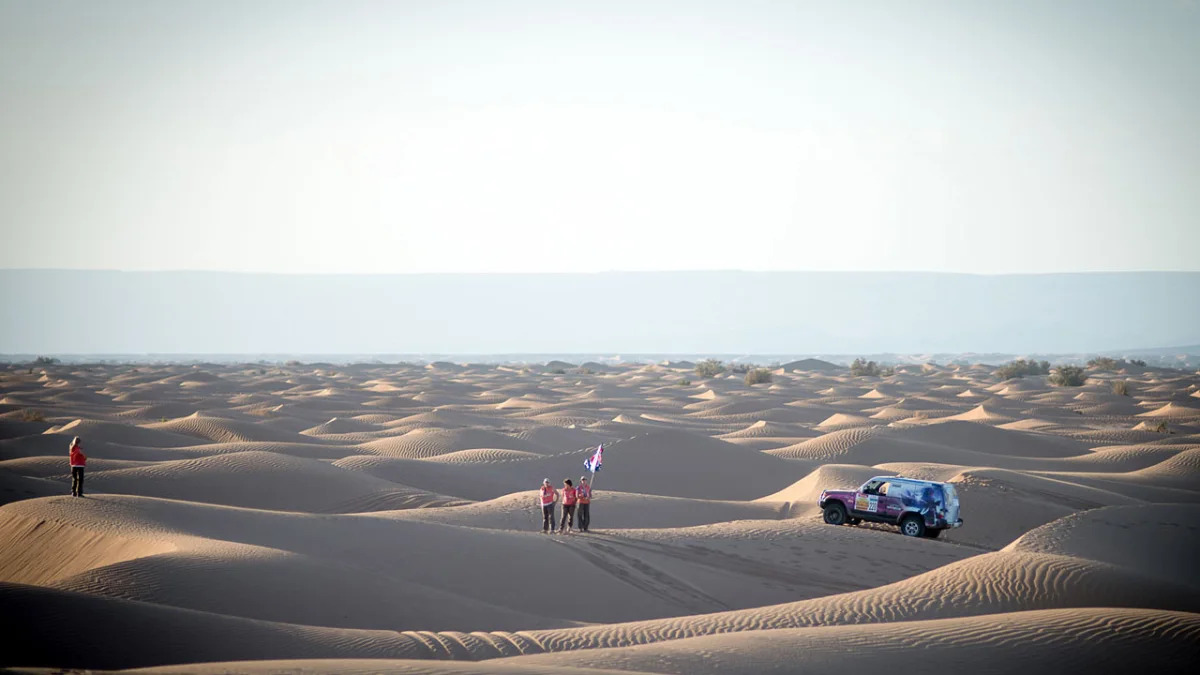









Sign in to post
Please sign in to leave a comment.
Continue